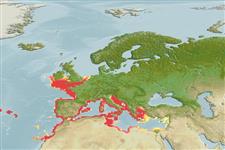Common names from other countries
Classification / Names / Names
Common names | Synonyms | Catalog of Fishes (gen., sp.) | ITIS | CoL | WoRMS
Environment: milieu / climate zone / depth range / distribution range
Ecology
Benthic; depth range 10 - 180 m (Ref. 113223). Subtropical, preferred 9°C (Ref. 107945); 53°N - 27°N, 32°W - 36°E (Ref. 114316)
Eastern Atlantic and the Mediterranean.
Length at first maturity / Size / Weight / Age
Maturity: Lm ? range ? - ? cm Max length : 11.0 cm SHL male/unsexed; (Ref. 109255); max. reported age: 40 years (Ref. 8702)
An active suspension feeder (Ref. 96376). Infaunal, found on sandy substrates (Ref. 113223).
Life cycle and mating behavior
Maturity | Reproduction | Spawning | Eggs | Fecundity | Larvae
Members of the class Bivalvia are mostly gonochoric, some are protandric hermaphrodites. Life cycle: Embryos develop into free-swimming trocophore larvae, succeeded by the bivalve veliger, resembling a miniature clam.
Gaspar, M.B., M.N. Santos, P. Vasconcelos and C.C. Monteiro. 2002. (Ref. 2736)
IUCN Red List Status (Ref. 130435)
CITES status (Ref. 108899)
Not Evaluated
Not Evaluated
Human uses
Fisheries: commercial
FAO - Fisheries: landings | FishSource | Sea Around Us
Tools
Internet sources
Estimates based on models
Preferred temperature
(Ref.
115969): 10.8 - 21.5, mean 18.7 (based on 822 cells).
Resilience
Medium, minimum population doubling time 1.4 - 4.4 years (K=0.21-0.38; tmax=40).
Vulnerability
Low vulnerability (10 of 100).
